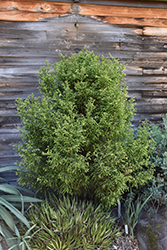It's all about ...
plants

Lemonade Japanese Cedar
Cryptomeria japonica 'Lemonade'
Height: 20 feet
Spread: 8 feet
Sunlight:
![]()
![]()
Hardiness Zone: 5a
Description:
A graceful conical shrub in the Cypress family, with stunning foliage that emerges yellow and slowly ages to blue-green; a perfect garden or landscape accent shrub that is sure to draw attention; displays some bronzing in winter
Ornamental Features
Lemonade Japanese Cedar is primarily valued in the landscape for its distinctively pyramidal habit of growth. It has attractive bluish-green foliage with hints of chartreuse which emerges yellow in spring. The scale-like sprays of foliage are highly ornamental and remain bluish-green throughout the winter.
Landscape Attributes
Lemonade Japanese Cedar is a multi-stemmed evergreen tree with a distinctive and refined pyramidal form. It lends an extremely fine and delicate texture to the landscape composition which can make it a great accent feature on this basis alone.
This is a relatively low maintenance tree, and should not require much pruning, except when necessary, such as to remove dieback. It has no significant negative characteristics.
Lemonade Japanese Cedar is recommended for the following landscape applications;
- Accent
- Vertical Accent
- Mass Planting
- General Garden Use
Planting & Growing
Lemonade Japanese Cedar will grow to be about 20 feet tall at maturity, with a spread of 8 feet. It has a low canopy with a typical clearance of 1 foot from the ground, and is suitable for planting under power lines. It grows at a slow rate, and under ideal conditions can be expected to live for 40 years or more.
This tree does best in partial shade to shade. It prefers to grow in average to moist conditions, and shouldn't be allowed to dry out. This plant will benefit from an application of bonemeal and/or mycorrhizal fertilizer at the time of planting. It is particular about its soil conditions, with a strong preference for rich, acidic soils, and is able to handle environmental salt. It is quite intolerant of urban pollution, therefore inner city or urban streetside plantings are best avoided, and will benefit from being planted in a relatively sheltered location. Consider applying a thick mulch around the root zone in winter to protect it in exposed locations or colder microclimates. This is a selected variety of a species not originally from North America.
This plant is not reliably hardy in our region, and certain restrictions may apply; contact the store for more information.
